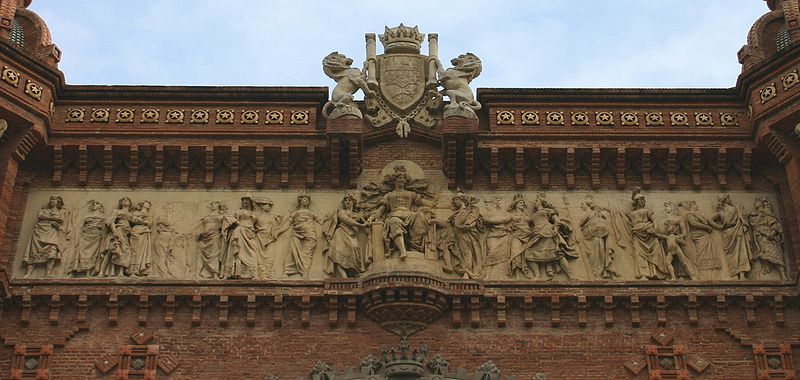Large panels sculpted by Josep Reynés depict citizens of Spain welcoming victors to their city and personifications of Agriculture and Industry (similar to the USSR’s Hammer and Sickle, although Spain was never communist….) In addition to a Coat of Arms and prowling lions (traditional symbols of power and strength), there are allegories of women and victory as well. Barcelona wanted to assert itself as an emerging city that would gain increasing importance in global politics and industry; the new century was dawning, and with it, Barcelona’s preeminence. Although the fair would have sprawled out behind the Arc 130 years ago, today, the Parc de la Ciutadella is behind it (it’s near the beach as well!). The Parc behind has a line of palm trees, Gaudi-esque lamp posts, and a beautiful view of Barcelona. As for the style of the Arc, the barrel vault is borrowed from Ancient Rome, although the coffers in the ceiling have been replaced by brick ribs.

The façade combines the Mudéjar (Moorish) style with traditional European imagery (i.e. winged women, draped figures in a procession). The turrets ending in rounded balls, the geometric patterns inlaid in the brick, and the predominantly reddish tones are from Moorish (and Muslim) architecture. Other fascinating details include the crosses and crowns in the archivolts above the vault, quatrefoils enclosed in mosaic squares, and gargoyle figures guarding the entrance. Although the day I visited this Arc was blasting hot, the shade and the view under the Arc and in the tree-lined promenade was worth it.
 On the other hand, the most famous Arc de Triomphe was built in 1806 in the Avenue Champs-Élysées. The architect was Jean Chalgrin, but the most famous relief panel, Le Départ de 1792(La Marseillaise), was sculpted in the Neoclassical Style by Francois Rude. The Arc was built to commemorate all the soldiers who had recently died in the bloody French Revolution (started 1789) and Napoleonic Wars (including his campaigns in Egypt, Russia, etc.) Although construction started under Napoleon after his victory at Austerlitz, he was never able to walk under it (only his casket passed under the vault). Interestingly, the body of Victor Hugo (author of Les Miserables, Hunchback of Notre Dame) was even taken under the Arc before his burial in the Pantheon. The Arc de Triomphe, in the center of a roundabout, contains a sculpted frieze, triglyphs, and metopes with bosses in the center (characteristic of severe neoclassicism).
On the other hand, the most famous Arc de Triomphe was built in 1806 in the Avenue Champs-Élysées. The architect was Jean Chalgrin, but the most famous relief panel, Le Départ de 1792(La Marseillaise), was sculpted in the Neoclassical Style by Francois Rude. The Arc was built to commemorate all the soldiers who had recently died in the bloody French Revolution (started 1789) and Napoleonic Wars (including his campaigns in Egypt, Russia, etc.) Although construction started under Napoleon after his victory at Austerlitz, he was never able to walk under it (only his casket passed under the vault). Interestingly, the body of Victor Hugo (author of Les Miserables, Hunchback of Notre Dame) was even taken under the Arc before his burial in the Pantheon. The Arc de Triomphe, in the center of a roundabout, contains a sculpted frieze, triglyphs, and metopes with bosses in the center (characteristic of severe neoclassicism).

Sources:
http://en.wikipedia.org/wiki/Arc_de_Triomphe
http://www.aviewoncities.com/barcelona/arcdetriomf.htm
http://en.wikipedia.org/wiki/Arc_de_Triomf
https://www.youtube.com/watch?v=-VZge2gUF3


Sources:
http://en.wikipedia.org/wiki/Arc_de_Triomphe
http://www.aviewoncities.com/barcelona/arcdetriomf.htm
http://en.wikipedia.org/wiki/Arc_de_Triomf
https://www.youtube.com/watch?v=-VZge2gUF3

No comments:
Post a Comment